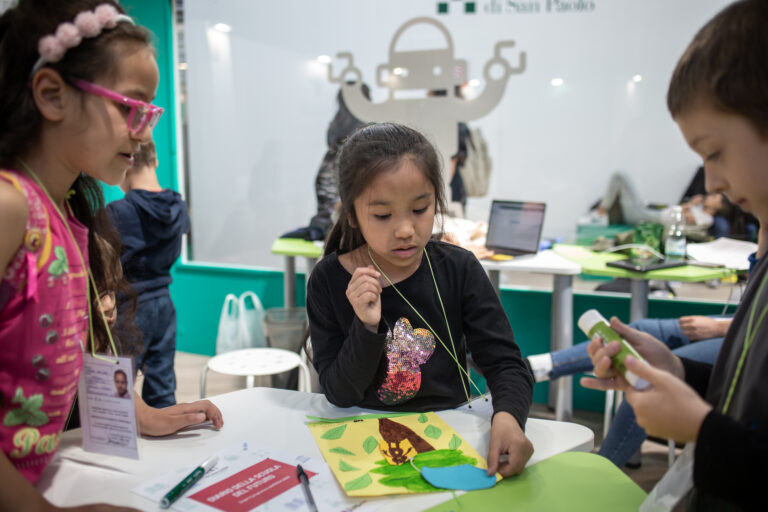Riconnessioni Torino was managed by Fondazione per la Scuola from 2017 to 2020. The project involved all primary and lower-secondary schools in Turin and its metropolitan area. Participating schools engaged in the educational innovation initiative through interventions around connectivity, community-building, and professional development. We connected school buildings to a dedicated fiber-optic network, involved teachers in professional development pathways, promoted a critical and conscious use of information technologies in teaching and learning, facilitated peer-to-peer collaboration and co-design processes involving research institutions, innovators, and schools.
We consider Riconnessioni Torino to be a case study to learn from for replication in other territories.
In Riconnessioni Torino we developed a metropolitan fiber-optic connectivity infrastructure (1 to 10 GBPS) which connected 233 schools, in partnership with Open Fiber. The infrastructure was realized using a star topology to guarantee each school point-to-point connectivity with the network’s central node.
Connectivity service transit and provision is managed by the TOP-IX consortium (Torino Piemonte Internet Exchange). This solution was strategic, as it involved an Internet Exchange Point which was able to exchange high-speed traffic between schools and other Internet Exchange Points, reducing latency.
Internet access is managed by Consorzio GARR, which provides symmetrical 10 GB connectivity which is ready for future upgrades (scalable performance). The GARR network was developed to be the Italian Network of Universities and Scientific Research. It is a high-speed connection which brings together universities, research centers, libraries, museums, schools, and other places devoted to learning, science, culture, and innovation throughout the country. Thanks to its technical characteristics, the GARR network allows for extremely low latency in data transmission, making it ideal for the transfer of large amounts of data, real-time communication, educational platforms, interactive tools for content creation, transmission and streaming of multimedia content
School buildings involved in the project were equipped with Aruba HPE network devices, with network infrastructure managed through a cloud-base control centre by Axians. This centralized authentication mechanism guarantees access to Wi-Fi in any Riconnessioni Torino school with the same personal credentials.
We brought together all primary and lower-secondary schools in Turin and its metropolitan area to embark on a voyage towards digital and pedagogical innovation.
We started by inviting teachers and headteachers to a 2-day workshop. Participants worked together, supported by facilitators, to co-design the following aspects of the project:
![]()
consolidate digital competences and enable pedagogical innovation and inclusion
![]()
alignment between training operations and school calendars and needs
![]()
5 teachers per school building participating in workshops and leading trickle-down training
![]()
a written commitment outlining responsibilities of each school and of Fondazione per la Scuola
Teachers, headteachers and administrative staff were involved in professional development pathways aimed at consolidating digital competences and enabling pedagogical innovation and inclusion, based on the DigComp European frameworks.
Professional development was aimed at the design, development and testing of lesson plans involving one or more disciplines, which were shared by teachers in our Lesson Plan Gallery. We developed this section of our websites to allow teachers to share lesson plans and be inspired by one another.
During the 9 months following their participation in the training labs, teachers returned to their schools and trained their colleagues, sharing learning and the lesson plans they developed with them. Thanks to a protocol with the national and regional Ministry of Education, Riconnessioni’s teacher training was included in the national training plan, allowing trickle-down training to reach around 60% of the teaching staff in participating schools.
Monitoring and evaluation of the training offering was carried out by ASVAPP.
Monitoring supported constant re-design of the training pathways in their various iterations thanks to timely reporting, gathering of feedback, and oversight on project advancement more broadly.
We asked ourselves:
Did Riconnessioni’s training affect teachers’ competences?
Did involvement in the project affect students’ competences?
Impact evaluation was both quantitative and qualitative. 76 headteachers, 2,423 teachers, and 4,258 students participated in the Riconnessioni test, designed to measure changes in digital competences and socio-emotional skills. The test was administered twice with a two-year interval. Control groups were used.
Results show that Riconnessioni’s actions produced a 10% increase in teachers’ digital competences. This was particularly strong in teachers who had actively participated in the training programme, and less in those who had only been involved through trickle-down training. The project brought more visible effects on the competences of primary school students than in lower-secondary school students.
